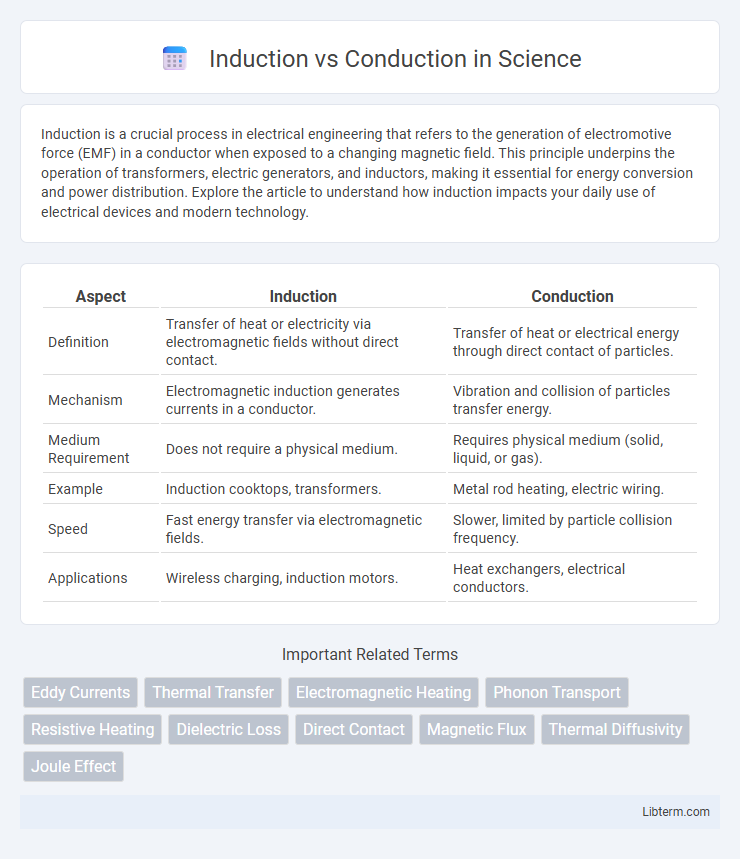Induction is a crucial process in electrical engineering that refers to the generation of electromotive force (EMF) in a conductor when exposed to a changing magnetic field. This principle underpins the operation of transformers, electric generators, and inductors, making it essential for energy conversion and power distribution. Explore the article to understand how induction impacts your daily use of electrical devices and modern technology.
Table of Comparison
| Aspect | Induction | Conduction |
|---|---|---|
| Definition | Transfer of heat or electricity via electromagnetic fields without direct contact. | Transfer of heat or electrical energy through direct contact of particles. |
| Mechanism | Electromagnetic induction generates currents in a conductor. | Vibration and collision of particles transfer energy. |
| Medium Requirement | Does not require a physical medium. | Requires physical medium (solid, liquid, or gas). |
| Example | Induction cooktops, transformers. | Metal rod heating, electric wiring. |
| Speed | Fast energy transfer via electromagnetic fields. | Slower, limited by particle collision frequency. |
| Applications | Wireless charging, induction motors. | Heat exchangers, electrical conductors. |
Introduction to Induction and Conduction
Induction involves the transfer of heat or electricity through a magnetic field without direct contact, relying on electromagnetic forces to generate current or heat inside a conductive material. Conduction is the process where heat or electricity is transmitted through direct contact between molecules in a solid or fluid, moving from a region of higher temperature or potential to lower. Both phenomena are fundamental in physics and engineering, influencing the design of electrical devices, heating systems, and thermal management solutions.
Defining Induction: Principles and Applications
Induction relies on electromagnetic fields to transfer energy, generating currents in conductive materials without direct contact, a principle fundamental to devices like induction cooktops and transformers. This process exploits Faraday's law of electromagnetic induction, where a changing magnetic field induces an electric current, enabling efficient, rapid heating and wireless energy transfer. Applications span from industrial metal heating and wireless charging systems to magnetic flow meters, emphasizing induction's role in modern electrical engineering and energy management technologies.
Understanding Conduction: Key Concepts
Conduction is the transfer of heat through direct molecular collision within a solid material, where thermal energy moves from high to low temperature regions. Key concepts include thermal conductivity, which measures a material's ability to conduct heat, and Fourier's Law that quantifies heat transfer rate through conduction. Effective conduction relies on material properties such as atomic structure and temperature gradient, making metals prime conductors due to free electron movement.
How Induction Works in Everyday Life
Induction works by generating an electromagnetic field that transfers energy directly to a conductive object, such as a pot or pan, causing it to heat up rapidly and efficiently. This process eliminates the need for a traditional flame or heating element, commonly seen in induction cooktops and charging devices. Everyday applications like induction stoves provide precise temperature control and enhanced safety by only heating the cookware, not the surrounding area.
The Science Behind Conduction
Conduction is the transfer of thermal energy through direct molecular collisions within a solid or between materials in physical contact. Heat moves from regions of higher temperature to lower temperature by vibrating molecules that pass energy to adjacent particles. Materials with high thermal conductivity, such as metals like copper and aluminum, facilitate faster conduction due to their free electrons that transfer energy efficiently.
Induction vs Conduction: Key Differences
Induction transfers heat through electromagnetic fields without direct contact, primarily heating conductive materials like metals, while conduction involves direct molecular collisions within a material to transfer heat. Induction heating offers faster, more efficient energy transfer with precise control, contrasting with conduction's reliance on physical contact and slower heat propagation. Materials with high electrical conductivity enhance induction efficiency, whereas conduction effectiveness depends on thermal conductivity and material density.
Energy Efficiency: Induction Compared to Conduction
Induction cooking is more energy-efficient than conduction because it directly heats the cookware through electromagnetic fields, minimizing heat loss. Conduction transfers heat from the burner to the pan, often resulting in significant energy wastage due to heat dissipation into the surrounding air. Induction cooktops typically convert around 85-90% of energy into cooking heat, compared to about 40-55% efficiency for traditional conduction methods.
Safety Aspects of Induction and Conduction
Induction cooking offers enhanced safety by generating heat directly in the cookware through electromagnetic fields, preventing the cooktop surface from becoming excessively hot and reducing burn risks. Conduction relies on direct heat transfer from a hot surface to the pot, increasing the likelihood of accidental contact burns and heat-related injuries. Induction cooktops also automatically shut off when no compatible cookware is detected, further minimizing fire hazards compared to traditional conduction stovetops.
Technological Advancements in Induction and Conduction
Technological advancements in induction have led to the development of highly efficient induction cooktops using electromagnetic fields for rapid, precise heating with minimal energy loss. Meanwhile, conduction technology has improved through innovative materials like graphene-enhanced thermal interfaces, enabling faster heat transfer and enhanced durability in electronics and cookware. Both methods benefit from smart sensors and automation, optimizing heat distribution and energy consumption in modern appliances.
Choosing Between Induction and Conduction: Which Is Better?
Choosing between induction and conduction cooking depends on factors like efficiency, safety, and cooking style, where induction offers faster heating and greater energy efficiency due to electromagnetic technology. Conduction relies on direct heat transfer through contact, suitable for traditional cookware and slower, precise temperature control. For energy savings and speed, induction is better; for versatility and familiarity, conduction may be preferred.
Induction Infographic

 libterm.com
libterm.com